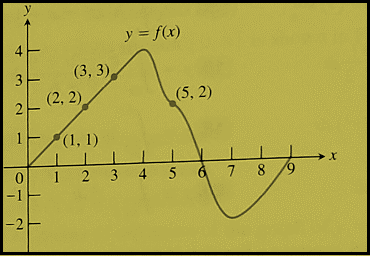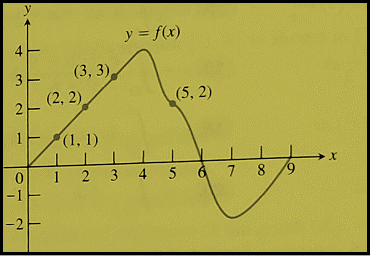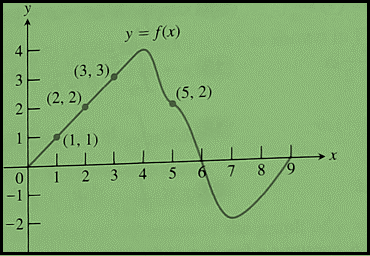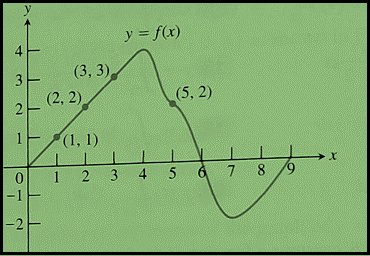
a.
The particle’s velocity at time
a.
Answer to Problem 64E
The velocity of particle at time
Explanation of Solution
Given:
Graph of function

Position of particle at any time
Concept Used:
Velocity: The velocity of a particle is the change in its position over time.
Also,
Calculation:
According to graph of function,
Point
The velocity of a particle is the change in its position over time then
So,
Now, velocity of particle at time
Put
Conclusion:
The velocity of particle at time
b.
The acceleration of the particle at time
b.
Answer to Problem 64E
The acceleration of the particle at time
Explanation of Solution
Given:
Graph of function

Concept Used:
Theorem: If the derivative of a function is positive on an interval then the function is increasing on that interval; if derivative is negative on that interval then the function is decreasing.
Also,
Calculation:
The acceleration of particle is slope of the graph.
Now, according to graph
The graph is negative in the neighborhood of
So, the acceleration of the particle at time
Conclusion:
The acceleration of the particle at time
c.
The particle’s position at time
c.
Answer to Problem 64E
The particle’s position is
Explanation of Solution
Given:
Position of particle at any time
Calculation:
Position of particle at any time
This is the area of the region from
Graph is

Now, according to graph
Base of triangle
And,
Height of triangle
Now,
Area of triangle
So,
The particle’s position at time
Conclusion:
The particle’s position at time
d.
The particle’s position has maximum value in time interval
d.
Answer to Problem 64E
The position function
Explanation of Solution
Given:
Graph of the function is

Position of particle at any time
And,
Calculation:
A function
Now, first derivative of position function
For maxima minima put
According to graph, at
Also, function changes its values from positive to negative so, position function
Hence,
Conclusion:
The position function
e.
Find the approximate value of
e.
Answer to Problem 64E
The acceleration is zero at
Explanation of Solution
Given:
Graph of the function is

Also,
Calculation:
According to graph, function has
And, acceleration
Now,
So, at
Hence, the acceleration is zero at
Conclusion:
The acceleration is zero at
f.
Find the value of
f.
Answer to Problem 64E
The particle moves away from the origin in time interval
The particle moves toward to the origin in time interval
Explanation of Solution
Given:
Graph of the function is

Position of particle at any time
Also,
Calculation:
The particle moves toward to the origin when the area of region is negative and moves away from the origin when the area of region is positive.
Now,
Position of particle during time
So, the particle moves away from the origin in time interval
And, position of particle during time
So, the particle moves toward to the origin in time interval
Conclusion:
The particle moves away from the origin in time interval
The particle moves toward to the origin in time interval
g.
The particle lie on which side of the origin at time
g.
Answer to Problem 64E
The particle lie on the right side of the origin at time
Explanation of Solution
Given:
Graph of the function is

Also,
Calculation:
According to the graph, the area of the region lie above the
Conclusion:
The particle lie on the right side of the origin at time
Chapter 5 Solutions
Advanced Placement Calculus Graphical Numerical Algebraic Sixth Edition High School Binding Copyright 2020
 Calculus: Early TranscendentalsCalculusISBN:9781285741550Author:James StewartPublisher:Cengage Learning
Calculus: Early TranscendentalsCalculusISBN:9781285741550Author:James StewartPublisher:Cengage Learning Thomas' Calculus (14th Edition)CalculusISBN:9780134438986Author:Joel R. Hass, Christopher E. Heil, Maurice D. WeirPublisher:PEARSON
Thomas' Calculus (14th Edition)CalculusISBN:9780134438986Author:Joel R. Hass, Christopher E. Heil, Maurice D. WeirPublisher:PEARSON Calculus: Early Transcendentals (3rd Edition)CalculusISBN:9780134763644Author:William L. Briggs, Lyle Cochran, Bernard Gillett, Eric SchulzPublisher:PEARSON
Calculus: Early Transcendentals (3rd Edition)CalculusISBN:9780134763644Author:William L. Briggs, Lyle Cochran, Bernard Gillett, Eric SchulzPublisher:PEARSON Calculus: Early TranscendentalsCalculusISBN:9781319050740Author:Jon Rogawski, Colin Adams, Robert FranzosaPublisher:W. H. Freeman
Calculus: Early TranscendentalsCalculusISBN:9781319050740Author:Jon Rogawski, Colin Adams, Robert FranzosaPublisher:W. H. Freeman
 Calculus: Early Transcendental FunctionsCalculusISBN:9781337552516Author:Ron Larson, Bruce H. EdwardsPublisher:Cengage Learning
Calculus: Early Transcendental FunctionsCalculusISBN:9781337552516Author:Ron Larson, Bruce H. EdwardsPublisher:Cengage Learning





